To reach UB we first had to fly to Beijing and then fly back. That was in June 2009, when the SARS epidemic was rocking the world. When we landed in Beijing and before we could disembark , some Chinese astronauts boarded the plane. We soon learned they were not astronauts but simply doctors who were checking the passengers' fever and controlling whether they were coughing. It was a strange sight though. Are those Chinese overdoing everything ? We finally managed to get out of the plane, all having passed our physical with flying colors.
Ulan Bataar is Mongolia's capital and also its largest city. UB started life as a nomadic monastic settlement. Because it consisted of felt tents, the capital was easily transported when the grass went dry. So it changed place twenty-eight times before finally moving to its current location on the Tuul River in 1778. At that time, most of its inhabitants were monks. It is only in 1924 that UB got its actual name , meaning Red Hero in honor of the communist triumph, and was declared the capital of independent Mongolia (though it was independent from China but not Russia). From the 1930's, the Soviets built the city in typical Soviet style: lots of ugly apartment blocks. Unfortunately, they also destroyed almost all the existing monasteries and temples. So there is very little today in this place which is so old and used to be glorious. The only buildings of interest I saw in UB were two museums and especially the National Museum of Mongolian History where there are interesting exhibits of deer stones and burial sites from the Hun, Göktürk and Uygur eras. There was also a very rich collection of costumes, hats and jewellery as well as armours of the Mongol hordes. Did it seem so interesting to me because I am Turkish, I cannot decide. Would this museum attract everybody's attention or only those who see remnants of their ancestors ?
 |
| GÜLTEKİN - 8TH CENTURY |
 |
| A GÖKTÜRK STELE - 8TH CENTURY |
 |
| UYGUR FRESCO - 9TH CENTURY |
 |
| THE VERY FAMOUS CENGİZ HAN |
 |
| OGEDAİ HAN - SON OF CENGİZ AND RULER OF THE MONGOLS WHEN CENGİZ DİED İN 1229 |
 |
| KUBİLAY HAN - GRANDSON OF CENGİZ AND FOUNDER OF THE CHİNESE YUAN DYNASTY İN 1280 |
 |
| CLASSİCAL MONGOL DRESSES |
 |
| SHAMAN COSTUME |
I have to admit I had never expected to see in UB such organised museums where the exhibits are well documented and well presented .

Apart from the museums, the central square of UB called Sükhbaatar Square, named after the hero of independence from China (1921), Damdin Sükhbataar, who has an equestrian statue in the middle of the square, was also worth seeing. Formerly a communist state, Mongolia embraced democracy in 1990.
On one side of the square you have the Opera House (there is one even in UB ; what about Istanbul ?), and the parliament building on the other. And of course, the parliament building features a huge statue of Cengiz Han and his Mongol soldiers. For Mongols who traditionally revere their ancestors, Cengiz Han is a God. If Napoleon and Alexander are the pride of France and Greece, Cengiz Han is more than that for the Mongols; he is their star, their spiritual force and the object of not only national but also personal pride.
 |
| THE OPERA HOUSE |
 |
| THE PARLİAMENT |
 |
| CENGİZ HAN |
 |
| A MONGOL SOLDİER FROM THE HORDES OF CENGİZ HAN |
The strangest thing I saw in UB was a shop window with a huge sign saying ''Louis Vuitton opening soon''. Why would Louis Vuitton open a shop in this poor country of three million people of which most are still nomads ? Who is going to buy a bag at those prices ? If horses used bags, sales would be higher !
We then proceeded to visit on of the very few monasteries remaining in UB, namely Gandan Monastery, meaning ''the Great Place of Complete Joy''. Building started in 1838 and at the beginning of the 20th century, colleges of Buddhist philosophy, medicine, astrology and tantric ritual were established making Gandan the center of Buddhist learning in Mongolia. It may have been a beautiful place, but after the Stalinist purges of the 1930's and reconstruction, I have to admit Gandan was not one of the most interesting monasteries I have seen.
The only interesting spot was the main building, which used to house a 20 meter gold statue of Avalokitesvara built in 1911. This statue was taken to Leningrad by the Soviets in 1937 ; its fate is still unknown. One theory is that it is still held in storage, whereas another theory is that it was melted to make bullets.
In 1996, a new statue was erected and was consecrated to the Dalai Lama. It is 26,5 meters high, weighs 20 tons, and is made from copper gilded with gold donated from Nepal and Japan. It is covered in gold brocade and over 500 meters of silk. The statue contains precious stones, 27 tons of medicinal herbs, 334 sutras (religious texts), 2 million mantras (religious words) and, in the base, an entire ger plus furniture.
 |
| BUDDHİST PRAYER WHEELS |
The next morning we left the city to travel towards the countryside and the Gobi Desert. This is what I was waiting for. We were in several 4x4 Toyota Land Cruiser (in my experience the best car for weird roads) and speeding in the wilderness. Driving in the countryside , you can pick any direction and go since there are no roads at all, only wheel tracks of those that passed there before you and everything is off road. So nice to have that kind of freedom. And talking of freedom, I saw my first horses, running as they pleased in the grassland. They were accompanied by real Mongol ''cowboys'', donned in regal robes, riding their horses to herd the animals. I watched with delight.
In this vast land, appeared on the horizon a settlement. What one calls settlement here consists of a few gers , the Mongols' house. This traditional Mongolian home is a nomad's prize possession. Gers can be erected in about an hour and are easily packed and moved. This is vital since nomads transfer their ger depending on the weather and the availability of vegetation for their sheep, yaks, horses or camels.
The circular shape and low roof are well suited to deflect wind. The door always faces south, giving protection against the predominantly northern winds. The felt used to make the ger is traditionally made by the herders themselves, often in late summer, from the wool of their own flocks. A typical ger's furnishing includes a central wood-burning stove, several beds, and the family altar. Although never locked, each ger also has a wooden door.
The Mongolian ger plays an important role in shaping both the Mongolian character and family life. A typical nomad family has about seven members and several hundred head of livestock. Mongolian nomads spend all day looking after their animals: herding, combing, milking and so on. Their livestock supply all their needs; sheep provide meat, leather and wool, goats milk and cashmere, cows and yaks milk and leather. Their traditional mode of transportation is the horse or camel but more and more nomads nowadays possess trucks or motorcycles. Usually by itself in the middle of wilderness, the small confines of a ger compels families to interact with one another (not that there are many people around to interact), to share everything, to work together, tightening family bonds. It also makes inhibitions fade away, preventing any kind of privacy. But some of those characteristics change as technology develops. Today some of the gers, set up in the middle of nowhere, have put up sattelite dishes and have TV sets to pass the time during the long evenings.
 |
| THE STOVE |
 |
| THE FAMİLY ALTAR |
We then came to our first Övoo, large piles of rock with blue, yellow and red cloth banners, which are repositories of offerings for the local spirits. Övoos come from Shamanism, the dominant belief system of Cengiz Han and his hordes. Shamanism is based on the shaman who has special medical and religious powers. One of the shaman's main duties is to cure any illness caused by the soul straying from its path and another is to accompany the soul of a dead person to the other world. Shamans act as intermediary between the human and the spiritual worlds.
Shamanism survived communist purges because there was no book, statue or temple to destroy and today it still mixes with Buddhism in Mongolia.
To have good luck, the only thing you have to do is to walk clockwise three times around an övoo and toss an offering into the pile. Another stone will be enough.
We finally reached the Orhun Valley (320 km from UB) where I would meet my ancestors: the Göktürks (or Blue Turks or Celestial Turks) and the Orhun İnscriptions .
For many centuries, the Orhun Valley was viewed as the seat of the imperial power of the steppes. Whoever controlled this valley was considered the heavenly appointed leader of the Turks and could rally the tribes. Thus control of the valley was of the utmost strategic importance for every Turkic state. Historically, every Turkic capital was located here but everything is gone now. The Orhun Inscriptions found here are memorial installations erected by the Göktürks in the 8th century.
The Göktürks were the first Turkic people known to write their language in an old Turkic script. These were written in stone around 732-735 and the script was deciphered by a Danish linguist in 1893. The Göktürks appeared on the stage of history in the first half of the 5th century when a state was founded by Bumin Han whose brother, İstemi Han ruled the western part. After the death of Bumin Han, the state went through one of its most powerful periods duing the reign of Mohan Han (552-572) where relations with even the Byzantine Empire were formed. Due to the weakness of subsequent rulers, the Göktürk State came under Chinese sovereignty in 630. After 50 years of Chinese domination, Kutlutekin brought the Turks together again and was given the name of İlteris Kağan. His chief minister, Tonyukuk, played a major part in the affairs of the state. When İlteris died in 691, his son being too young, his brother Kopgan Kağan ascended the throne and in this period the boundaries of the Göktürk State extended to Caucasia in the West, Tibet in the South and to Siberia in the North, all people living under a single flag. In 716, Bilge Kağan (son of İlteris) took over the throne and he governed in peace and welfare with his brother Gültekin , with still Tonyukuk as Grand Vizir. After the death of Gültekin and Tonyukuk, chaos began in the state and this led to the dissapearance of the Göktürks from the stage of history. They were replaced by an Uygur State. In 1229, the Mongols under Cengiz Han put a definite end to Turkic rule in the region.
What remains to us from those days are the Orhun Inscriptions, two steles erected in 732 upon the orders of Bilge Kağan, when his brother Gültekin died in 731. On those steles, there are inscriptions in both Chinese and Turkish relating the legendary origins of the Turks, their subjugation by the Chinese, their liberation by Bilge Kağan and stressing unity among Turkish tribes. And that is how we know today what took place during the Göktürk era.
 |
| BUİLDİNG HOUSİNG THE GÖKTÜRK İNSCRİPTİONS AND İTS GUARD. THE BUİLDİNG WAS CONSTRUCTED BY TİKA, THE TURKİSH İNTERNATİONAL COOPERATİON AND DEVELOPMENT AGENCY. |
 |
| A FAKE İNSCRİPTİON İN İTS ORİGİNAL PLACE WİTH THE TORTOİSE BASE. |
 |
| THE ORİGİNAL GÜLTEKİN AND BİLGE KAĞAN İNSCRİPTİONS |
 |
| GÖKTÜRK ALPHABET |
 |
| HOUSE (!) OF THE MUSEUM GUARD WİTH İTS SATELLİTE DİSH. |
We then reached our first ger camp. Yes, we also are going to sleep in gers for a few days, since you cannot find a hotel in the middle of nowhere. These are touristic ger camps, but the gers are real, the only difference being that there is a small building near the camp where showers and bathrooms are located. Try to avoid going to the bathroom in the middle of the night since , as there are no lights, you have to find your flashlight, get dressed up and go out in considerably cold weather. As their doors are always unlocked, if you are too cold, someone even passes all through the night, while you are asleep, to re-kindle the fire in your stove to keep you warm. But you have to ask for this service before going to sleep.
 |
| EVERY TİME I WENT İN MY GER I HİT MY HEAD. |
JUST CLİCK TO LİSTEN
The next morning we are in Kharkorin or Karakurum (not to be mixed with the mountains and highway between Pakistan and China), which first served as a rallying point for Cengiz Han's troops. By 1220, it became pretty much the capital of the world when the city was made the center of Cengiz Han's empire. Permanent structures were erected only after Cengiz Han's death by his son and successor Ögeday Han. Nevertheless, Karakurum served as the political, cultural and economic capital of the Mongols for only forty years before Kubilay Han moved the Mongol capital to Khanbalik, later to become Beijing. Following this move and the subsequent collapse of the Mongolian empire, Karakurum was abandoned and destroyed by vengeful Manchurian soldiers in 1388. Whatever was left was used to construct the Erdene Zuu Khiid (monastery) in the 16th century (which itself was badly damaged during the Stalinist purges). So today, there is unfortunately little left to recall the ancient glory of Karakurum.
The only remnant of the old city is one single ''turtle rock'', four of which marked the boundaries of old Karakurum. The turtles were acting as protectors of the city since in those times they were considered a symbol of eternity. The turtles originally had an inscribed stone stele mounted on their back.
 |
| THE ORHUN RİVER |
 |
| KARAKURUM TODAY |
 |
| THE TURTLE ROCK |
We then went to see the ''phallic rock'', a rock pointing erotically to something interestingly called the ''vaginal slope''. Legend has it that this rock was placed here in an attempt to stop the monks of the monastery, filled with lust, from fraternising with local women. But today it has another purpose: all women who want a baby come here to pray for one.
After some friends insisted on at least putting their feet in the river so important for our ancestors, the Orhun, we continued to visit Erdene Zuu Khiid or Hundred Treasure Monastery, the first Buddhist monastery built in Mongolia, for which work started in 1586 but was completed only three hundred years later. The monastery had between sixty and one hundred temples, about three hundred gers were set up inside, and at its peak ten thousand monks were in residence. Unfortunately, during the Stalinist purges all but three temples in Erdene Zuu were destroyed and a great part of the monks were either killed or shipped to Siberia never to be heard of again. However, before being killed or shipped away, the monks managed to bury underground a surprising number of statues, masks and thangkas (religious cloth banner) that can be seen today in the monastery. The monastery remained closed until 1965 when it was permitted to re-open as a museum but not a place of worship. It was only after the collapse of communism in 1990 that religious freedom was restored and the monastery became active again.
 |
| ERDENE ZUU KHİİD |
 |
| OUTER WALL WİTH 108 STUPAS |
 |
| PRAYER TİME BUT THİS YOUNG MONK İS BUSY TEXTİNG ON HİS MOBİLE PHONE. |
 |
| TOURİSTİC CENGİZ HAN |
As in the Gobi there is only enough vegetation to maintain camels, we were at once greeted by them, the horse having totally disappeared from view.
 |
| WHİLE ALL OUR CARS SPED İN THE WİLDERNESS, I HAD A FEELİNG OF RİDİNG WİTH THE HORDES OF CENGİZ HAN. |
 |
| THE CAMELS HERE ARE OF THE TWO-HUMPED VARİETY. |
In the 1920's the world's most important find of dinosaur bones took place in the Gobi Desert and this place with red cliffs is now called Bayangaz Dinosaur Cliffs. Those striking red cliffs still have dinosaur fossils all over the place. It seems there are no resources to excavate them, so they are left lying in the sand.
We then visited a ''forest'' of saxaul trees which seemed to be frozen in place and time. A very interesting site, though too hot in the midday sun. Normal since we are in the middle of a desert. We were reminded of that last point when a huge sand storm started. Very strong winds came out of nowhere and we could not see anything anymore. We were in the 4x4 hoping our driver knew where he was going. A little while later, even though all the windows were closed, I started feeling the taste of sand in my mouth. Our driver told us not to worry, and a good sauna and massage would take the whole sand and tiredness away when we reached our ger camp. I did not believe him. We are going to a ger camp in the middle of the desert and in the middle of nowhere. What would a sauna and massage be doing there? Well, I was wrong because there really was sauna and massage at the ger camp.
The sand storm abated as quickly as it had begun and it seems we were lucky since sometimes it would last continuously for a few days. And we reached our ger camp in bright sunshine. After all that sand, showering in running hot water was a blessing.
 |
| THE MİDDLE OF NOWHERE |
 |
| BAYANGAZ DİNOSAUR CLİFFS |
 |
| SAXAUL TRESS ''FROZEN'' İN THE HEAT |
 |
| ONE OF THE SANDY PARTS OF THE GOBİ. |
 |
| WELCOME TO OUR GER CAMP |
| THE SUN HAS SET. İT İS COLD AND DARK |
 |
| THE TONYUKUK İNSCRİPTİON (720-725) DESCRİBİNG THE MİLİTARY HİSTORY OF THE GÖKTÜRKS AS TOLD BY TONYUKUK. |
We then drove to Terelj National Park which is very near UB and gives you the impression of being in the Mongolian countryside. İt is indeed the countryside but nothing like the one we saw on the way to the Gobi, or the Gobi itself. The main reason is that it is very touristic, even the passengers of the Trans-Siberian railway stopping here to see Mongolia. İt is not seeing the real thing but only a copy of it in my opinion. The ger camps are flashy, the nomad families seem to be here for the convenience of the tourist and even the wilderness seems ''manicured''.
What astonished me after the dryness of the Gobi was that everything here was under water. It seems it had rained a lot in the last few days, and the Tuul River had overflown its banks.
What astonished me after the dryness of the Gobi was that everything here was under water. It seems it had rained a lot in the last few days, and the Tuul River had overflown its banks.
 |
| GENERAL VİEW OF TERELJ |
 |
| VERY PASTORAL İNDEED |
 |
| YAKS |
What was nice, even if very touristic, is that a special Nadaam Festival, the most important festival in the country, had been organised for us. The Nadaam festival takes place very year in July and is part a family reunion, part fair and part nomad Olympics. Nadaam has its roots in the nomad assemblies and hunting extravaganzas of the Mongol armies. During the festival, traditional Mongolian sports are carried out : men compete in Mongolian wrestling matches, while young boys race horses across the steppe . Men and women of all ages compete in archery , all to the sound of local musicians playing the two-string horse hair violin and drums. Those Mongolian sports are an extension of the military training used for centuries by the Mongol clans.
 |
| IT ALL STARTED WİTH A LONG SPEECH FROM THE MASTER OF CEREMONİES. |
 |
| TO THE SOUND OF MUSİC |
 |
| WRESTLİNG WAS MADE İN SEVERAL ROUNDS. FİRST SOME WİNGED MOVEMENTS ARE MADE TO SYMBOLİZE DİFFERENT BİRDS. |
 |
| THEN THE FİGHT STARTS. |
 |
| THE FİRST TO TOUCH THE GROUND WİTH ANY PART OF THE BODY EXCEPT HANDS AND FEET LOSES. |
 |
| THE WİNNER MAKES AN ''EAGLE'' VİCTORY DANCE |
 |
| AND GOES FOR THE SECOND ROUND. |
 |
| A BOY WAİTS WİTH THE HAT OF THE FİGHTER WHO WİLL HAVE THE RİGHT TO PUT İT ON İF HE WİNS. |
 |
| PREPARATİONS ARE ON FOR THE HORSE RACE |
 |
| İN THİS COUNTRY PEOPLE LEARN TO RİDE A HORSE BEFORE THEY LEARN HOW TO WALK |
 |
| THİS İS A COMPETİTOR İN THE HORSE RACE. UNBELIEVABLE. YOU WONDER HOW HE CAN SİT ON THE HORSE WİTHOUT GOİNG OVERBOARD. |
 |
| ARCHERY HAS ALSO STARTED. ARCHERS HAVE TO CONSTANTLY FACTOR İN THE BLOWİNG WİND. |
 |
| ON THE SİDE, SHAMAN DANCES ARE ON. |
 |
AS WELL AS ''CONTORTİON'', A MONGOLİAN ART OF SHOWİNG THE
ABİLİTY OF THE HUMAN BODY TO EXPRESS ANYTHİNG.
|
And last but not least we were to watch Sham dances, a Buddhist dance with strong shamanistic influences where costumes and huge masks are worn by the dancers.
 |
 |
| ADMİT THAT THİS İS MADE TO BE EATEN. |
 |
| THOSE RED CHEEKS ARE FABULOUS. |
NOTE: In the text all names of people and places that are of Turkic or Turkish origin have been given in the Turkish alphabet and in the way they are used in Turkish.

















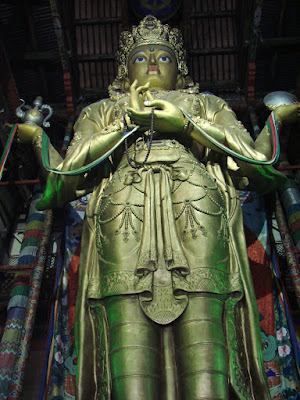

















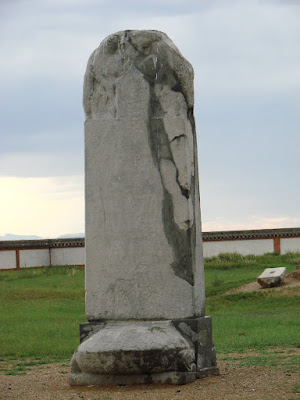












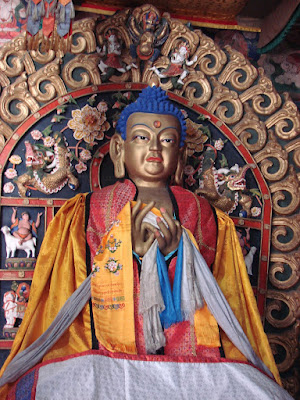



















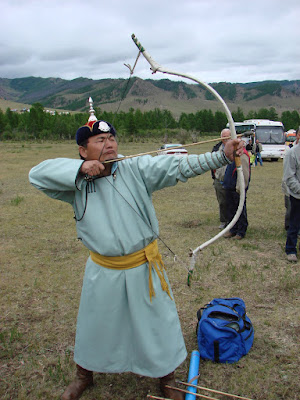











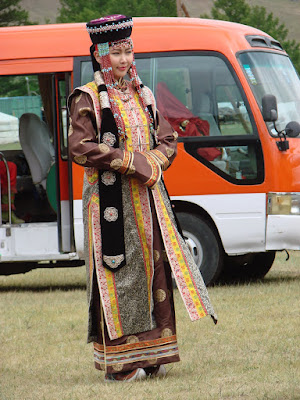




















No comments:
Post a Comment